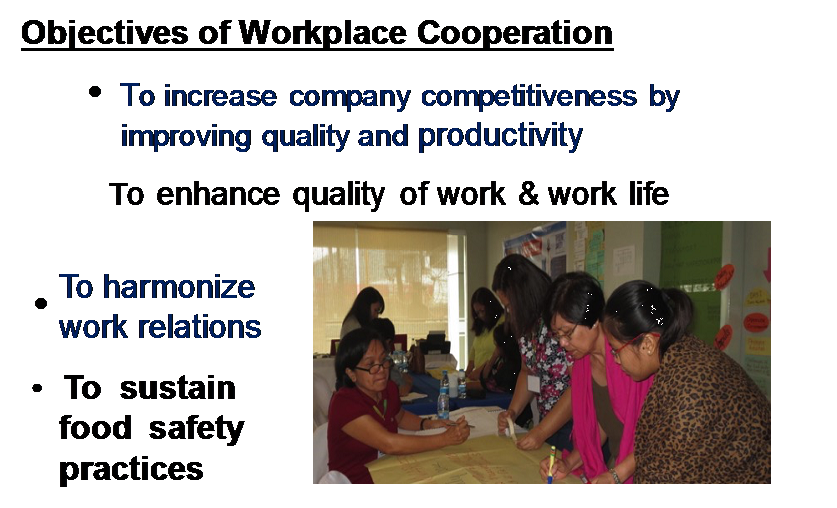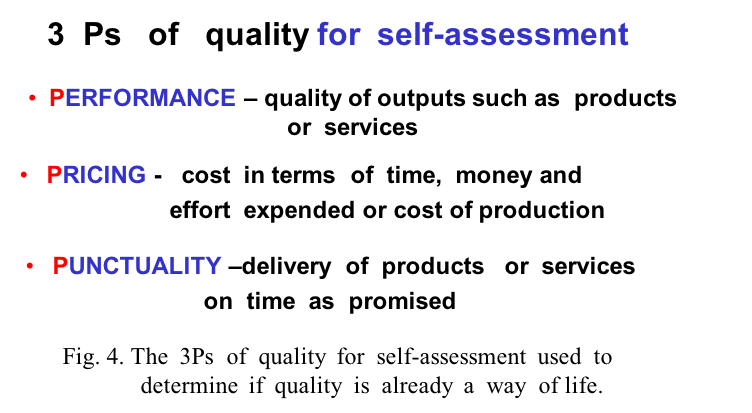Introduction
ALTHOUGH there are various global approaches to total quality, Gatchalian, JC and Gatchalian, MM, et. al. (2002) have noted that over the years, initiating and sustaining efforts towards total quality remains a major challenge in the Philippines. Years of local and international experience in this field, enriched by interactions and exchanges with fellow experts in global gatherings and conferences, bolstered their view that a culture-sensitive approach is needed to guide entrepreneurs in their journey towards total quality, where overall improvement through time can be measurable (Gatchalian MM, 2012). For instance, when food companies train their sights and gear their overall efforts towards total quality, central to their concerns are sanitary and hygienic practices becoming mindsets of everyone in the organization. This can be better achieved if a culture of food safety and quality is fostered not only at work – but also in the home and family life of their employees. (Gatchalian, JC and Gatchalian, MM, 1997).
Culture-based road map
The “SUGOD” approach (“sugod” means move-on together in Filipino), validated in several selected companies, is a simplified process to ensure continuity of efforts towards total quality, regardless of industry type, size or presence of workers’ organizations. (Gatchalian J.C. and Gatchalian MM, 2004). This is a culture-based road map cum framework towards a continual cycle of improvements to eventually attain total quality. The first letter for each word in the 5-Phases stands for the “SUGOD” acronym as shown in Figure 1. The Phases aim to involve everyone in the organization to work together to achieve a common goal. “SUGOD” also enables the organization to make an overview of its overall company direction (framework) while providing a step by step guide or road map for everyone to follow, motivated by a shared company vision and mission (Gatchalian, MM and De Leon, SY, et. al. 2016). From actual experience, it takes three cycles (about three years) of continual improvement measurements before total quality practices can be concretely observed through quantifiable trends.

Figure 1 The 5 phases of SUGOD
Pre-requisites to “SUGOD”. The conditionalities for the “SUGOD” intervention, expected to facilitate the implementation process include: (1) full support and leadership by Top Management – spearheaded by HRD; (2) understanding that “SUGOD” is both a framework and a road-map towards Total Quality (TQ); (3) acceptance that activities towards TQ is sustained through continual improvement; and (4) transparency of Management in the measurement of growth indicators. Once the Top Management is convinced that the approach could provide concrete benefits to the company, particularly in terms of stable employee engagement and tangible enhancement of profitability, the Phases of the road map would consequently progress smoothly. Phase I - ”SURVEY” is the entry-point of the intervention process in the company, and is perhaps the most difficult to conduct especially for SMEs. These firms usually have very limited documentation practices or know-how. Companies that have started their quality management system directions, or are already ISO 9000 certified, makes Phase I much easier to complete. It is also at the Survey Phase where the concept and practice of Workplace Cooperation is introduced. The other Phases are dependent on findings in Phase I, as well as, on a well-designed Phase II- UNITE which approach includes the sharing of the Company’s vision, mission, values and goals while identifying its strengths, weaknesses, opportunities and threats (SWOT). Once these are accomplished, the rest of the Phases usually elicit increasing support from a growing constituency and greater employee engagement and commitment are much easier to sustain.
One of the most distinctive marks of the “SUGOD” approach is an enhanced concern and commitment corresponding to the Filipino cultural value of “malasakit”. It is equated to individual and collective concern among the company leaders and the workers observed as early as in Phase I. This strengthens the employees’ commitment to become better employees with a strong desire to continually grow in knowledge and skills that fosters cooperative and harmonious work relations inside the company and filial relationships at home. Management’s positive response to their employees’ personal and collective aims and aspirations is best observed in the effective implementation of “Workplace Cooperation” (WPC), the “SUGOD” foundation for sustainability. This is a relatively recent adaptation of a global notion which, in the Philippine scenario, is basically a take-off from the earlier precepts of Labor Management Cooperation (LMC). The over-arching aim was to foster greater participation in workplace decisions and democratizing the relations between labor and management.
Workplace Cooperation (WPC). Figure 2 presents the objectives expected to be achieved through WPC – the mechanism that promotes better understanding between management and staff through improved communication and opportunities for working together to help in problem-solving. The overall effect of a sustained WPC program is tangible improvement of quality and productivity, thereby enhancing the company’s profitability and competitiveness. These are basically traced to the employee’s feeling and perception that he can contribute towards the betterment of his working conditions and to the achievement of the company’s over-arching vision and mission that will benefit all the members of the organization. Ultimately, the cooperative and harmonious working relationships would redound to the company’s successful quest for consistent product quality and assurance of sustainable food safety programs that can be the hallmark of the whole business.

Figure 2 Objectives of workplace cooperation (WPC)
Workplace Cooperation Steering Council or Committees (WSC). Filipino employees hope in general for caring Managements that show sincere concern for the plight of all their employees and who take concrete measures for their upliftment. Opportunities to convincingly show this can be provided through their involvement in the activities of the Workplace Cooperation Steering Council or Committees (WSC) of the WPC as shown in Figure 3. The WSC is composed of representatives of management and staff. These members may be designated by higher management and their counterparts elected from among the rank-and-file. Since all recommendations or decisions to be made by WSC are arrived at by consensus, then equality in membership number from both parties is not necessary. The search for “the one best way” to resolve problems or issues, should not be tackled by voting or in a “division of the house.” Chairmanships of WSC may rotate between staff and management representatives. This practice provides opportunities to develop problem-solving and leadership capabilities from among the staff members.

Figure 3 steering committee
The major activity of the WSC is to identify problem areas or issues that may be mutually addressed and jointly resolved – instead of being sources of conflict. The Task Forces (TFs) or Committees are sometimes referred to as “quality improvement teams” (QITs) because they may want to primarily tackle quality problems or issues. Members from management and staff are tasked to understand these specific problem areas in a systematic manner and to recommend solutions and recommendations that may be adopted and acted upon by the higher body called the WSC. The whole process is sustained through the well-defined WSC organizational structure and processes aimed at providing prompt response and action on the recommendations of the working committees. This is strengthened and encouraged by full support and prompt provision of required resources. A properly functioning WSC should eventually involve everyone in the organization for this to effectively demonstrate Management’s appreciation and regard for its people and their reciprocal “malasakit” for the company and their jobs. This “uniquely Filipino cultural trait” has been largely untapped. The adoption and practice of workplace cooperation can lead to total people involvement that can contribute immensely to the sustainability of the quality and food safety efforts of the organization.
Food safety sustainablity
Making “quality a way of life” (QWL) in the company is one of the major directions of the WPC approach in “SUGOD”. A self-assessment tool to determine if one is a quality person uses the 3Ps of quality as shown in Figure 4 which challenges everyone to monitor and assess one’s own progress in the journey to total quality. Embedded in the tool is “cleanliness” as a habit at home and at work and a Food Safety Standing Committee of WSC takes the responsibility of ensuring that this will sustain the food safety programs of the company.

Figure 4 the 3Ps of quality
Summary
‘SUGOD” (move-on together in Filipino) is a culture-based approach to total quality designed to properly address and utilize the Filipino cultural trait in an effort to improve work relationships and to ultimately enhance and then sustain product quality and food safety. The approach is based on years of testing of various methods to ensure that management and staff workers will be able to work together – harmoniously and productively. Modern approaches give much value to people at work such that Workplace Cooperation (WPC) has gained global recognition and practice. Adapting WPC to Filipino situations was strengthened by the many first-hand observations through the years, that Filipinos work best if there is “malasakit” (caring and concern for one another) and they work better if their aspirations to improve themselves and their families’ future can also be recognized and addressed by the organizational leadership. Once the roadmap and framework of “SUGOD” is appreciated, accepted and initiated by management, it is coupled with the concept and practice of WPC as the operational mechanism for pursuing sustainability through activation of its organizational structure which includes “Workplace Steering Council and Committees”. When WPC is in place, the five Phases of “SUGOD” (Phase I- Survey, II- Unite, III-Grow, IV-Operationalize, V-Develop) can more effectively function in cycles of continual improvement. This will eventually lead to the wider involvement of everyone in the food company and they become more active players in the quest for consistent quality and productivity, coupled with the assurance of a sustainable food safety program.
*DR. MIFLORA M. GATCHALIAN is CEO of Quality Partners Company, Ltd and an Academician Emeritus of International Academy for Quality
References
Gatchalian, J.C. and Gatchalian, MM, 1997. Quality of Work and Family Life–Explorations in South East Asia. Proceedings. International Industrial Relations Association (IIRA) Conference, Bologna , Italy.
Gatchalian, J.C. and Gatchalian, M.M. 2004. Labor Management Cooperation (LMCs in the New Millennium). 3rd Edition. 200 pages. Quality Partners Co., Ltd., Quezon City, Philippines
Gatchalian, J.C. Gatchalian, MM, Leano, A, Cortez J. 2002. “Partnerships for Quality: A Philippine Experience”. Proceedings.56thAnnual QC- ASQ- Denver, USA. American Society for Quality (ASQ).
Gatchalian, M.M. 2012. Phases of Total Quality Towards Competitiveness Improvement. Keynote Speech. Proceedings. VII International Quality Managers Forum. June 27-29, 2012, Almaty, Kazakhstan.
Gatchalian, M.M. and De Leon and Co-authors. 2016. Introduction to Food Technology: Focus
on Carbohydrate-rich Foods. Volume 1 2nd edition . 327 pages. Merriam and Webster
Bookstore, Inc. Manila Philippines. <myonlybookstore@gmail.com>
New Balance

 iConnectHub
iConnectHub
 Login/Register
Login/Register Supplier Login
Supplier Login


























